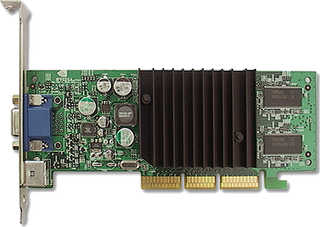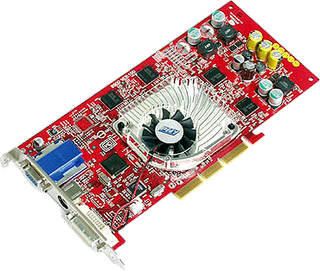From Voodoo to GeForce: The Awesome History of 3D Graphics
PowerVR Series 3 (Kyro)
In 2000, PowerVR released its first Kyro card, followed suit by the Kyro II in 2001. The future looked mighty bright for PowerVR, who by the end of the 2001 had reportedly sold over 1 million Kyro 1/2-based videocards and was giving both Nvidia and ATI a run for their money.
Based on the company's STG 4000X architecture, the original Kyro was built on a 0.25-micron manufacturing process and had two ROPs and two texture clocks, versus one each on the Neon 250. In addition to sticking with its tile- based rendering scheme, the Kyro added 8-layer multlitexturing, made easier thanks to the aforementioned tile-based rendering.
With the release of the STG 4500-based Kyro II in 2001, and later the Kyro II SE, performance got a much needed boost thanks the new version's faster clockspeeds, which put it in competition with Nvidia's GeForce2 MX. Success was short-lived, however, as the Kyro II was still a lower end performer, and the lack of hardware T&L didn't bode well for long-term success.
Fun Fact: PowerVR had shown the Linux community some love by announcing development of Linux drivers for its Kyro videocards.

(Image Credit: dansdata.com)
Model: Kyro
Date Released: 2001
Interface: AGP/PCI
Shader Model: N/A
DirectX: 6
Manufacturing Process: 0.25 micron
Core Clockspeed: 115MHz
Memory Clockspeed: 115MHz
Memory Bus: 128-bit
Transistors: 12 million

(Image Credit: overclockersonline.net)
The biggest gaming news, reviews and hardware deals
Keep up to date with the most important stories and the best deals, as picked by the PC Gamer team.
Model: Kyro II
Date Released: 2001
Interface: AGP
Shader Model: N/A
DirectX: 7
Manufacturing Process: 0.18 micron
Core Clockspeed: 175MHz
Memory Clockspeed: 175MHz
Memory Bus: 128-bit
Transistors: 15 million

(Image Credit: hwsw.hu)
Model: Kyro II SE
Date Released: 2001
Interface: AGP
Shader Model: N/A
DirectX: 7
Manufacturing Process: 0.18 micron
Core Clockspeed: 200MHz
Memory Clockspeed: 200MHz
Memory Bus: 128-bit
Transistors: 15 million
Nvidia GeForce 3 (NV20)
By the end of 2000, main rival 3dfx found itself in dire straights following a series of bad business moves, and it was Nvidia who acquired the storied 3D chip maker that December. Three months later, Nvidia released the GeForce 3, a new architecture with programmable vertex and pixel shaders, a new, more efficient memory manager, multi-sampling anti-aliasing, and DirectX 8 support.
Performance without all the eye candy turned on was very good, but the GeForce 3 would strut really its stuff once AA was enabled. In the fall of 2001, Nvidia would release faster clocked revisions in the Ti20 and Ti500, neither of which had dual-monitor support. But they were both high performance cards, with the latter boasting a max bandwidth of 8GB/s.

(Image Credit: slcentral.com )
Model: GeForce 3
Date Released: 2001
Interface: AGP
Shader Model: 1.1
DirectX: 8
Manufacturing Process: 0.15 micron
Core Clockspeed: 200MHz
Memory Clockspeed: 230MHz
Memory Bus: 128-bit
Transistors: 57 million

(Image Credit: nvnews.com )
Model: GeForce 3 Ti200
Date Released: 2001
Interface: AGP
Shader Model: 1.1
DirectX: 8
Manufacturing Process: 0.15 micron
Core Clockspeed: 175MHz
Memory Clockspeed: 200MHz
Memory Bus: 128-bit
Transistors: 57 million

(Image Credit: golem.de)
Model: GeForce 3 Ti500
Date Released: 2001
Interface: AGP
Shader Model: 1.1
DirectX: 8
Manufacturing Process: 0.15 micron
Core Clockspeed: 240MHz
Memory Clockspeed: 250MHz
Memory Bus: 128-bit
Transistors: 57 million
ATI Radeon R200
In late 2001, ATI unveiled its second generation Radeon along with its very first DirectX 8 compliant card, the Radeon 8500. Also for the first time, the R200 architecture propelled ATI from the also-ran crowd into direct competition with Nvidia, a rivalry we hope continues on for many more years to come.
The time around, ATI didn't waste time churning out SDR videocards, completely making the switch to DDR. Almost ever R200 would also come equipped with a 128-bit memory bus, save for a few rogue SE series cards aimed at the budget buyer. In addition, some later model cards (9000 series) would make the jump from AGP 4X to supporting 8X.
Support for DirectX 8.1 helped the R200 stand side by side, and in some cases, in front of the competition, albeit after early driver issues were ironed out.

(Image Credit: ixbt.com)
Model: Radeon 8500
Date Released: 2001
Interface: AGP
Shader Model: 1.4
DirectX: 8.1
Manufacturing Process: 0.15 micron
Core Clockspeed: 275MHz
Memory Clockspeed: 275MHz
Memory Bus: 128-bit
Transistors: 6 0 million

(Image Credit: sharkyextreme.com)
Model: Radeon 9000 Pro AIW
Date Released: 2003
Interface: AGP
Shader Model: 1.4
DirectX: 8.1
Manufacturing Process: 0.15 micron
Core Clockspeed: 275MHz
Memory Clockspeed: 270MHz
Memory Bus: 128-bit
Transistors: 6 0 million
Nvidia GeForce 4
With 3dfx out of the picture and the GeForce 3 putting on a strong showing, Nvidia didn't feel the need to overhaul its graphics chipset, and so it didn't. GeForce 4 was all about refining the existing core, which Nvidia did by making it faster, tweaking the memory controller, adding another vertext shader, and improving DVD playback.
GeForce 4 was an instant hit and Nvidia attacked every market segment with a barrage of videocards from the entry-level on up to the high-end. It was the GeForce 4 Ti4200 that stole the show, offering gamers exception performance for a fraction of the cost of higher end GeForce 4 parts. This made the middling Ti4400 somewhat of an outcast, as it didn't offer enough of a performance boost to justify skipping the Ti4200, and gamers looking for more pixel pushing oomph chose instead to jump straight to the Ti4600, and later the Ti4800.

(Image Credit: Dell)
Model: GeForce 4 MX 420
Date Released: 2002
Interface: AGP
Shader Model: 1.1
DirectX: 8
Manufacturing Process: 0.15 micron
Core Clockspeed: 250MHz
Memory Clockspeed: 166MHz
Memory Bus: 64-bit and 128-bit
Transistors: 57 million

(Image Credit: xbitlabs.com)
Model: GeForce 4 Ti4200
Date Released: 2002
Interface: AGP
Shader Model: 1.1
DirectX: 8
Manufacturing Process: 0.15 micron
Core Clockspeed: 250MHz
Memory Clockspeed: 500MHz
Memory Bus: 128-bit
Transistors: 57 million

(Image Credit: activewin.com)
Model: GeForce 4 Ti4600
Date Released: 2002
Interface: AGP
Shader Model: 1.1
DirectX: 8
Manufacturing Process: 0.15 micron
Core Clockspeed: 300MHz
Memory Clockspeed: 650MHz
Memory Bus: 128-bit
Transistors: 57 million

(Image Credit: pclab.pl)
Model: GeForce 4 Ti4800
Date Released: 2003
Interface: AGP
Shader Model: 1.1
DirectX: 8
Manufacturing Process: 0.15 micron
Core Clockspeed: 300MHz
Memory Clockspeed: 650MHz
Memory Bus: 128-bit
Transistors: 57 million
Next, surround gaming entices, and it's ATI's turn to be king.
Paul has been playing PC games and raking his knuckles on computer hardware since the Commodore 64. He does not have any tattoos, but thinks it would be cool to get one that reads LOAD"*",8,1. In his off time, he rides motorcycles and wrestles alligators (only one of those is true).
Most Popular




